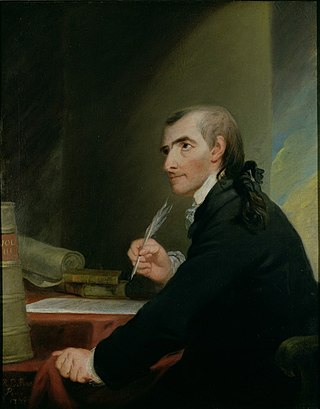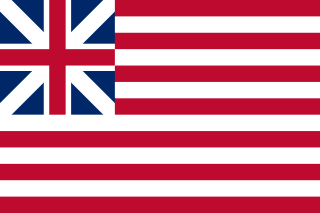The Easton flag is an early American flag used in modern times to represent Easton, Pennsylvania.
The Easton flag is an early American flag used in modern times to represent Easton, Pennsylvania.
The flag is designed differently from more common flags of the United States in that it has 13 (8-pointed) stars in a blue field, with 13 stripes in the canton. [1] The flag's design is consistent with the 1777 Flag Act, which does not specify the location of the stars and stripes: "That the flag of the thirteen United States be thirteen stripes, alternate red and white; that the union be thirteen stars, white in a blue field, representing a new constellation."
According to local legend, [2] the flag was hoisted when the Declaration of Independence was publicly read in Easton, Pennsylvania by Robert Levers on July 8, 1776, two days before a copy of the Declaration reached New York City. [3]
The flag was used as a company flag under Captain Abraham Horn in the War of 1812, and some suspect that the design may only date from this era. [4] [nb 1] This is considered unlikely by some, as flags would have had 15 stars and stripes in 1814. The flag was given in 1821 to the Easton library for safe-keeping when the company returned. The Easton Area Public Library still holds the flag. [5]

Francis Hopkinson was an American Founding Father, lawyer, jurist, author, and composer. He designed Continental paper money and two early versions of flags, one for the United States and one for the United States Navy. He was a signer of the Declaration of Independence in July 1776 as a delegate from New Jersey.

The national flag of the United States, often referred to as the American flag or the U.S. flag, consists of thirteen equal horizontal stripes of red alternating with white, with a blue rectangle in the canton, referred to as the union and bearing fifty small, white, five-pointed stars arranged in nine offset horizontal rows, where rows of six stars alternate with rows of five stars. The 50 stars on the flag represent the 50 U.S. states, and the 13 stripes represent the thirteen British colonies that declared independence from Great Britain, which they obtained in their victory in the American Revolutionary War.

The Great Seal is a national symbol of the United States. The phrase is used both for the impression device itself, which is kept by the United States secretary of state, and more generally for the impression it produces. The obverse of the Great Seal depicts the national coat of arms of the United States while the reverse features a truncated pyramid topped by an Eye of Providence. The year of the U.S. Declaration of Independence, 1776, is noted in Roman numerals at the base of the pyramid. The seal contains three Latin phrases: E Pluribus Unum, Annuit cœptis, and Novus ordo seclorum.

The flags of the Confederate States of America have a history of three successive designs during the American Civil War. The flags were known as the "Stars and Bars", used from 1861 to 1863; the "Stainless Banner", used from 1863 to 1865; and the "Blood-Stained Banner", used in 1865 shortly before the Confederacy's dissolution. A rejected national flag design was also used as a battle flag by the Confederate Army and featured in the "Stainless Banner" and "Blood-Stained Banner" designs. Although this design was never a national flag, it is the most commonly recognized symbol of the Confederacy.

The coat of arms of the Philippines features the eight-rayed sun of the Philippines with each ray representing the eight provinces which were placed under martial law by Governor-General Ramón Blanco Sr. during the Philippine Revolution, and the three five-pointed stars representing the three major island groups of Luzon, the Visayas, and Mindanao.

The national flag of the Philippines is a horizontal bicolor flag with equal bands of royal blue and crimson red, with a white, equilateral triangle at the hoist. In the center of the triangle is a golden-yellow sun with eight primary rays, each representing a province. At each vertex of the triangle is a five-pointed, golden-yellow star, each of which representing one of the country's three main island groups—Luzon, Visayas, and Mindanao. The white triangle at the hoist represents liberty, equality, and fraternity. A unique feature of this flag is its usage to indicate a state of war if it is displayed with the red side on top, which is effectively achieved by flipping the flag upside-down.

The national flag of Malaysia, also known as the Stripes of Glory, is composed of a field of 14 alternating red and white stripes along the fly and a blue canton bearing a crescent and a 14-point star known as the Bintang Persekutuan. The 14 stripes, of equal width, represent the equal status in the federation of the 13 member states and the federal territories, while the 14 points of the star represent the unity among these entities. The crescent represents Islam, the country's state religion; the blue canton symbolises the unity of the Malaysian people; the yellow of the star and crescent is the royal colour of the Malay rulers. It is in the stars and stripes family of flags.

The flag of Bosnia and Herzegovina contains a medium blue field with a yellow right triangle separating said field, and there are seven full five-pointed white stars and two half stars top and bottom along the hypotenuse of the triangle.

The Ohio Burgee is the official flag of the U.S. state of Ohio. It is a triangular swallowtail flag. Its red, white, and blue elements symbolize the state's natural features and order of admission into the Union. A prominent disc in the flag's triangular canton is suggestive of the state's name. The flag was adopted in 1902.

The flag of the State of Israel was adopted on 28 October 1948, five months after the Israeli Declaration of Independence. It consists of a white background with a blue Star of David in the centre and two horizontal blue stripes at the top and bottom, recalling the design of the tallit (טַלִּית). The Israeli flag legislation states that the official measurements are 160 × 220 cm. Therefore, the official proportions are 8:11. Variants can be found at a wide range of proportions, with 2:3 being common.

The flag of Colorado was officially adopted to represent the U.S. state of Colorado on June 5, 1911. The flag, designed by Andrew Carlisle Carson, consists of a fess design of three horizontal stripes of equal width, with the top and bottom stripes colored blue, and the middle stripe colored white. A circular red "C", filled with a golden disk, sits atop the stripes. All aspects of the flag contain symbolism related to the state, as the blue is meant to represent the sky, the gold the abundant sunshine the state receives, the white the snowcapped Rocky Mountains, and the red the "ruddy" earth. The gold and white portions of the flag also represent the state's gold and silver mining industries, respectively.

The flag of Chicago consists of two light blue horizontal bars, or stripes, on a field of white, each bar one-sixth the height of the full flag, and placed slightly less than one-sixth of the way from the top and bottom. Four bright red stars, with six sharp points each, are set side by side, close together, in the middle third of the flag's surface.

The Flag Acts are three laws that sought to define the design of the flag of the United States. All the submitted suggestions were remarkably short, the shortest being a sentence of 31 words, and the longest being a title and two sentences of 117 words.

The "Grand Union Flag", or the "Continental Colors", also known as the "Congress Flag", the "Cambridge Flag", and the "First Navy Ensign", was the first, unofficial national flag of the United States of America. First hoisted on December 3, 1775 by naval officer John Paul Jones, the flag was used heavily by the Second Continental Congress of the United States, and by George Washington, commander-in-chief of the Continental Army during the American Revolutionary War.

The ensign of the United States is the flag of the United States when worn as an ensign. International maritime law—see International Treaty on Law of the Sea, articles 91 and 92—provides that vessels have a "national character" and thus should display a flag (ensign) that corresponds to this national character, especially when in international or foreign waters. Vessels that are formally documented under the federal vessel documentation act, vessels owned by government bodies in the United States, and vessels in the U.S. military unquestionably have U.S. national character, and thus properly hoist a U.S. ensign to show their national character. Vessels that are numbered by the states and small, non-registered craft owned by U.S. citizens and not registered in other countries may also hoist a U.S. ensign to show their national character.
The following is a timeline of the flag of the United States.

The Bennington flag is a version of the American flag associated with the American Revolution Battle of Bennington, from which it derives its name. Its distinguishing feature is the inclusion of a large '76' in the canton, a reference to the year 1776 when the Declaration of Independence was signed.

The Betsy Ross flag is a reconstructed early design for the flag of the United States, which is conformant to the Flag Act of 1777 and has red stripes outermost and stars arranged in a circle. These details elaborate on the 1777 act, passed early in the American Revolutionary War, which specified 13 alternating red and white horizontal stripes and 13 white stars in a blue canton. Its name stems from the story, once widely believed, that shortly after the 1777 act, upholsterer and flag maker Betsy Ross produced a flag of this design.

The Cowpens flag, or 3rd Maryland flag, is an early version of the United States flag that meets the congressional requirements of the Flag Resolution of 1777. Like the Betsy Ross flag, the white stars are arranged in a circle on a blue field; but the circle consists of just 12 stars, with the 13th star in the center.

The Easton Area Public Library serves Easton, Pennsylvania in Northampton County, Pennsylvania. It is a Carnegie library and was predated by a community library constructed by the Easton Library Company in 1811. With a grant in 1901 for $57,000 by industrialist Andrew Carnegie a new library began construction at 515 Church Street and was completed in 1903.
| | This section is empty. You can help by adding to it. (March 2023) |